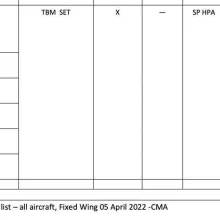Patrick L posted in General Aviation
Hello,
after a recent discussion among peers I am trying to get some clarification on "Class Rating Questions".
In principle, there seems to be an illogical application of Class Ratings in the regulatory structure.
As the name beholds, a Class Rating pertains to a "Class" e.g. SEP or SET. In the case of SET, each type has been assigned a separate Class.
What is the legal basis within 1178/2011 or elsewhere that separates aircraft of the same class into individual ratings and requires differences training between Class Rating airplane variants (where no OSD exists) as defined in the "Type Rating and license endorsement list", see https://tinyurl.com/easaratings legally binding?
In other words I’m trying to establish wether mandatory differences training as per the "Type Rating and license endorsement list, 05 April 2022, CMA" between variants (as indicated by a horizontal line — is correct according to the law,
if the variants in question are
- not type rating aeroplanes
- no OSD exists
- all variants are the same TCDS.
Some excerpts (EASA document content in ""):
„The lists indicate if Operational Evaluation Guidance Material (OE GM) or Operational Suitability Data (OSD) flight crew are available, as described in Article 7a of Commission Regulation (EU) No 748/2012.“
>> Let's take, as an example, the TBM models. For TBM, no OSD exists. Only OE GM aka. „guidance material“ which is not legally binding.
„EASA type certificate data sheets (TCDSs) and the list of EASA supplemental type certificates contain further references to OSD. Complete current OSD information is held by the relevant type certificate (TC) or STC holder.
Furthermore, the lists provide aircraft-specific references relevant to flight crew qualifications and air operations.
FCL.010 ‘Definitions’ defines types of aircraft as follows:
‘type of aircraft’ means a categorisation of aircraft requiring a type rating as determined in the operational suitability data established in accordance with Annex I (Part-21) to Regulation (EU) No 748/2012 (OSD), and which includes all aircraft of the same basic design including all modifications thereto except those which result in a change in handling or flight characteristics.“
>> Not applicable to TBM as it is a Class Rating, not a Type Rating airplane.
„Aircraft class ratings
Aircraft class rating designations are incorporated within the lists.
Aircraft within a class rating are not individually listed, except for all aircraft within the class rating SET and for other aircraft with specific provisions.
Class rating ‘SET’ for single pilot (SP) single-engine (SE) turbo-prop aircraft
The class rating ‘SET’ for SP SE turbo-prop aircraft is established within the lists. All aircraft within the class rating SET are listed individually in the table. Aircraft are added to the class rating SET following EASA classification. Aircraft which had previously been designated as ‘SET’ by the Joint Aviation Authorities (JAA) under the provisions of JAR-FCL 1 are retained in the class rating ‘SET’ without further assessment.“
>> Ok, nice, but why? Legal basis for this "classification"?
„[…..] Finally, the lists indicate whether aircraft have been classified as variants. Flight crew type rating and variant designations are established by EASA through the OSD flight crew evaluation process and are only valid for the evaluated aircraft make and model.“
>> Where is it written in the law how aircraft variants are categorized if there is no OSD?
„Aircraft variants
1. Aircraft within class ratings
Aircraft within class ratings do not have associated OSD in accordance with Part-21. The ‘EASA type rating and licence endorsement lists — flight crew’ provide categories of class ratings — such as SEP, MEP, SET, etc.— and indicate aircraft which are considered as variants.
Aircraft within the same class rating which are separated by a horizontal line in the tables require differences training, whereas those aircraft which are contained in the same cell require familiarisation when transitioning from one aircraft to another
Refer to GM1 FCL.135.A; FCL.135.H DIFFERENCES AND FAMILIARISATION TRAINING:
(a) Differences training requires the acquisition of additional knowledge and training on an appropriate training device or the
aircraft."
>> What is the definition of „appropriate training device“?
"(b) Familiarisation requires the acquisition of additional knowledge.
All aircraft within the same class rating MEP or SET require differences training, unless indicated otherwise in the list."
>> Again, why?
Reason I am asking, particular regarding Class Rating "TBM SET" in this context:
The EASA "Type Ratings and Licence endorsements lists" assigns e.g the TBM 930, among other "trade names", to the entry for the TBM700N. The guidance material OE GM suggests that the only difference with, e.g. the TBM 940, lies in the Garmin avionics. The formal variant is “TBM 700 N”, and from a type certificate point of view, there's no such thing as a 930 or 940. It's just a marketing term. As the TBM 700 N is clearly defined as one variant within the TCDS, absent a defined OSD, should there even be a requirement for differences training. The published OE GM is optional.
Is it conceivable that dividing the various trade name "sub-variants" of the TBM 700 N in the endorsements list is a mistake?
And further, a familiarisation would be applicable? According Annex IV to the Basic Regulation (Essential Requirements for Aircrew), all pilot training requires a structured course with a syllabus. Hence the term "familiarisation training" was changed to "familiarisation", since the latter doesn't require a structured course with a syllabus.
Add on question:
Regarding the revalidation of Class Rating Instructor ratings, e.g. for an instructor holding CRI SEP and CRI TBM SET, is it sufficient to meet the revalidation criteria for either SEP vs. SET, or must it be met separately for each?
Thanks in advance for your input!
Best regards,
Patrick

Please log in or sign up to comment.